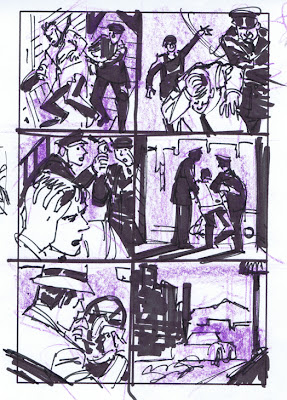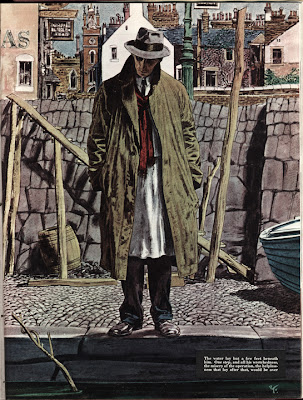There is a great exercise in of the Famous Artists Course, called "Basic Thinking and Arranging", where you are given three design elements and by manipulating them you work out what you want to do with your picture. I've always thought the exercise was brilliant, but I've tried to add to the process.
With the Famous Artist Course you are only dealing with design, and how reworking that can change the impact of your picture. The major element that isn't discussed in this case, is story: what is the creator of the picture trying to communicate to his viewer.
For myself as an illustrator, STORY is the essential ingredient for the design process. The Famous Artists Course stresses the concept of keeping things simple. When I am drawing a frame, I usually try to identify it by a single word (fear, disgust, death) or phrase (moves toward, hides from,etc.). Once I have that basic concept in mind I do one, or a series of quick "thumbnail drawing." Thumbnails are small quick sketches used to plan the finished drawing. (The word “cartoon” actually defines the initial planning sketches artists used for larger works of art- now when we talk about “cartoon” it can be the finished work.)
If your pictures start getting too ornate and difficult to follow you need to do some editing. Your pictures can still be complicated, but they should be concise. Often times several objects, props, or characters, might serve as a single element, such as a crowd scene. One element might be an elaborately decorated piece of latticework, or a cityscape with people in every window. That elaborate and highly textured cityscape will still be read quickly and be assimilated if it is properly designed. My favorite illustrator is Robert Fawcett, whose pictures are always a myriad of texture and detail, but the basic shapes in the composition are always few.
I prefer not to get too “finished” with my thumbnails. This gives me the opportunity later to adjust compositions, change the angle of shots, and rework scenes if necessary. If the thumbnail is already a tight little drawing I’m less apt to want to take the work to go back and change it. My old friend Eric Radomski got me used to using the fattest marker I could find for this process, which forces you to work with big shapes and very simply. You can always make the drawings pretty later on in the process. (And if it looks too pretty to begin with, you might hesitate to make the necessary changes. )
You can break all of your shots down into three basic types: Establishing (long) shot, Medium Shot and Close-up. Each of them has a specific purpose ( and an infinite variety of approaches.)
So let's look at this process using a very hackneyed plot concept: A young woman alone in a house is threatened by a maniac with a knife. The three "elements" I've chosen for this picture are 1. the woman, 2. the knife, and 3. a window.
If I were to label this frame "suspense", I might design something like the picture below. The woman is in the foreground, in danger but unaware, but the window serves as a buffer between her and the hand with the knife outside.
And the permutations are endless as you change "elements" of the elements themselves.
A butcher knife suggests something different from a stiletto, and a butter knife suddenly changes it to comedy.
Who holds the knife is another question. In a massive hand, it suggests one thing, in a delicate hand there is a different story.
long shots are great for setting the scene. And the emotion of the woman can change the story dramatically: is she terrified, or ready to take charge.
And lastly, how you choose your camera angles, and the lighting you set up will also be a factor.
Hey, it's not easy, is it. And just think, this is only one frame. Comics and storyboards are made of up hundreds (or thousands) of little pictures. and then there are story beats and continuity....but that's a discussion for another day.


















Hi Mike,
ReplyDeleteI think there's no better trainer to teach good old comic book drawing tasks as you.
Best from Germany
Michael
Great Demo, Mike! Thanks for speaking at Art Center, you were fantastic!
ReplyDelete